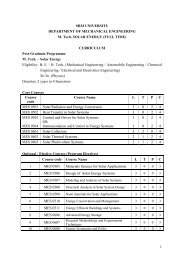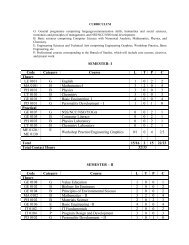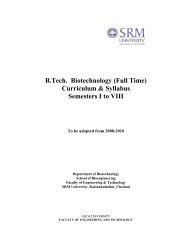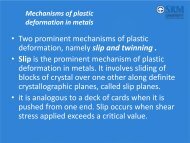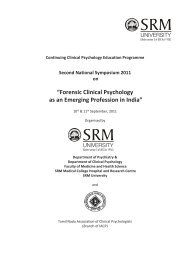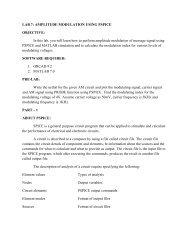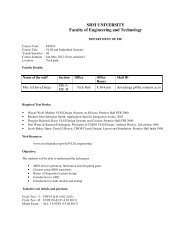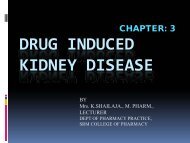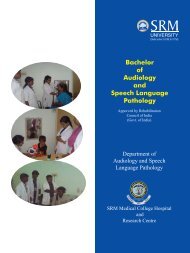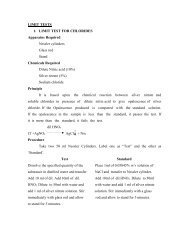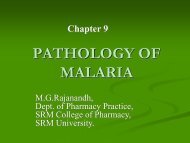ACUTE, SUBACUTE AND CHRONIC TOXICITY IN ANIMALS
ACUTE, SUBACUTE AND CHRONIC TOXICITY IN ANIMALS
ACUTE, SUBACUTE AND CHRONIC TOXICITY IN ANIMALS
Create successful ePaper yourself
Turn your PDF publications into a flip-book with our unique Google optimized e-Paper software.
Chapter 5: <strong>ACUTE</strong>,<br />
SUB<strong>ACUTE</strong> <strong>AND</strong> <strong>CHRONIC</strong><br />
<strong>TOXICITY</strong> <strong>IN</strong> <strong>ANIMALS</strong><br />
Year III Pharm.D<br />
Dr. V. Chitra
<strong>IN</strong>TRODUCTION<br />
A drug is a single substance or mixture of substances used for diagnosis,<br />
treatment, mitigation or prevention of disease ; restoring, correcting or<br />
modifying the organic functions in man or animals (W.H.O.)<br />
Agents of these potential activities interfere with biological processes of the<br />
host or extraneous etiological agents and hence are toxic substances.<br />
The object of toxicity testing in the laboratory is to elucidate the toxic<br />
properties of drugs
<strong>ACUTE</strong> <strong>TOXICITY</strong> STUDIES<br />
The Globally Harmonized System (GHS),defines it as "those adverse effects occurring<br />
following oral or dermal administration of a single dose of a substance, or multiple<br />
doses given within 24 hours, or an inhalation exposure of 4 hours"<br />
The preferred species for oral and inhalation testing is the rat, and for dermal testing,<br />
the rat or rabbit<br />
Oral administration is the most common form of acute systemic toxicity testing.
Five Organisation for Economic Cooperation and Development (OECD) Test<br />
Guidelines (TGs 402, 403, 420, 423, and 425) describe acute systemic testing.<br />
Fixed Dose Procedure (OECD TG 420)<br />
Acute Toxic Class method (OECD TG 423)<br />
Up‐and‐Down Procedure (OECD TG 425)<br />
Acute Dermal Toxicity OECD TG 402,<br />
Acute inhalation toxicity OECD TG 403.
<strong>IN</strong>ITIAL CONSIDERATIONS<br />
The testing laboratory should consider all available information on the test substance<br />
prior to conducting the study.<br />
The identity and chemical structure of the substance<br />
Its physico‐chemical properties<br />
The results of any other in vitro or in vivo toxicity tests on the substance<br />
Toxicological data on structurally related substances;<br />
The anticipated use(s) of the substance
DESCRIPTION OF THE METHOD<br />
Selection of animal species<br />
Housing and feeding conditions<br />
Preparation of animals<br />
Preparation of doses
PROCEDURE<br />
Administration of doses<br />
Limit test at 2000mg/kg<br />
Limit test at 5000mg/kg<br />
Main test<br />
Observations<br />
Body weight<br />
Pathology
DATA <strong>AND</strong> REPORT<strong>IN</strong>G<br />
‣Data<br />
‣Calculation of LD50<br />
‣Test report<br />
The test report must include the following information, as appropriate:<br />
Test substance:<br />
− physical nature, purity, physico‐chemical properties (including isomerisation);<br />
− identification data.<br />
Vehicle (if appropriate):<br />
− justification for choice of vehicle, if other than water.<br />
Test animals:<br />
− species/strain used;<br />
− microbiological status of the animals,<br />
− number, age and sex of animals<br />
− source, housing conditions, diet etc.
Test conditions:<br />
− details of test substance formulation, including details of the physical form of the materia<br />
administered;<br />
− details of the administration of the test substance including dosing volumes and time of<br />
dosing;<br />
− details of food and water quality (including diet type/source, water source);<br />
− the rationale for the selection of the starting dose.<br />
Results:<br />
− tabulation of response data and dose level for each animal (i.e. animals showing signs of<br />
toxicity including mortality, nature, severity and duration of effects);<br />
− tabulation of body weight and body weight changes;<br />
− individual weights of animals at the day of dosing, in weekly intervals thereafter, and at<br />
time of death or sacrifice;<br />
− date and time of death if prior to scheduled sacrifice;<br />
− time course of onset of signs of toxicity and whether these were reversible for each<br />
animal;<br />
− necropsy findings and histopathological findings for each animal, if available.<br />
Discussion and interpretation of results.<br />
Conclusions.
SUB<strong>ACUTE</strong> <strong>AND</strong> <strong>CHRONIC</strong> <strong>TOXICITY</strong> TEST<strong>IN</strong>G<br />
The Globally Harmonized System (GHS)defines it as "specific target organ/systemic<br />
toxicity arising from a repeated exposure"<br />
Repeated dose toxicity testing using oral administration of a test substance in rodents<br />
for 28 and 90 days is used to evaluate chronic toxic effects, primarily effects on various<br />
organ systems, and to establish a no observed effect level<br />
Chronic toxicity testing consists of oral, dermal, and inhalation subacute repeated<br />
dose studies (28‐day) and subchronic repeated dose studies (90‐day) in rodents.<br />
. The endpoints for repeat dose testing consist of an evaluation of clinical observations,<br />
blood analysis, whole body gross necropsy, and microscopic examination of all organs<br />
and tissues (histopathology)
The objectives of chronic toxicity studies covered by this test<br />
guideline include:<br />
The identification of the hazardous properties of a chemical,<br />
The identification of target organs,<br />
Characterisation of the dose:response relationship,<br />
Identification of a no‐observed‐adverse‐effect level (NOAEL) or<br />
point of departure for establishment of a Benchmark Dose (BMD),<br />
The prediction of chronic toxicity effects at human exposure levels,<br />
Provision of data to test hypotheses regarding mode of action
Six OECD Test Guidelines describe short‐term repeat‐dose toxicity testing:<br />
Repeated Dose 28‐day Oral Toxicity Study in Rodents (TG407)<br />
Repeated Dose 90‐Day Oral Toxicity Study in Rodents (TG 408)<br />
Repeated Dose Dermal Toxicity: 21/28‐day Study (TG 410)<br />
Subchronic Dermal Toxicity: 90‐day Study (TG 411)<br />
Repeated Dose Inhalation Toxicity: 28‐day or 14‐day Study (TG 412)<br />
Subchronic Inhalation Toxicity: 90‐day Study (TG 413)
Initial considerations<br />
Description of the method,<br />
selection of animal species<br />
Housing and feeding conditions<br />
Preparation of animals<br />
Preparation of doses<br />
Observations<br />
Ophthalmological examination<br />
Body weight, food/water consumption and food efficiency<br />
Haematology and clinical biochemistry<br />
Pathology gross necropsy<br />
Histopathology
Test report<br />
The test report should include the following information:<br />
• Test substance:<br />
Physical nature,<br />
Purity<br />
Physicochemical properties;<br />
Identification data;<br />
Source of substance;<br />
Batch number<br />
•Vehicle (if appropriate):<br />
Justification for choice of vehicle (if other than water).<br />
• Test animals:<br />
Species/strain used and justification for choice made;<br />
Number, age, and sex of animals at start of test;<br />
Source, housing conditions, diet, etc.;<br />
Individual weights of animals at the start of the test.
• Test conditions:<br />
Rationale for route of administration and dose selection;<br />
When applicable, the statistical methods used to analyse the data;<br />
Details of test substance formulation/diet preparation, achieved concentration, stability<br />
homogeneity of the preparation;<br />
Route of administration and details of the administration of the test substance;<br />
For inhalation studies, whether nose only or whole body;<br />
Actual doses (mg/kg body weight/day), and conversion factor from diet/drinking water<br />
Test substance concentration (mg/kg or ppm) to the actual dose, if applicable;<br />
Details of food and water quality.
Absorption data<br />
Results<br />
Survival data;<br />
Body weight<br />
Food consumption, calculations of food efficiency and water consumption<br />
Toxic response data by sex and dose level, including signs of toxicity;<br />
Nature, incidence (and, if scored, severity), and duration of clinical observations<br />
Ophthalmological examination;<br />
Haematological tests;<br />
Clinical biochemistry tests;<br />
Urinalysis tests;<br />
Investigations of neurotoxicity or immunotoxicity<br />
Terminal body weight;<br />
Organ weights (and their ratios, if applicable);<br />
Necropsy findings;<br />
Detailed description of all treatment‐related histopathological findings;
Statistical treatment of results, where appropriate.<br />
Body weights,<br />
Organ weights,<br />
Feed consumption (or water consumption) and food efficiency.<br />
Draft consultant’s proposal. V. 8. OECD TG 452 November, 2008 12<br />
Discussion of results including:<br />
Dose:response relationships<br />
Consideration of any mode of action information<br />
Discussion of any modelling approaches<br />
Historical control data<br />
Relevance for humans<br />
• Conclusions
REFERENCES<br />
www.alttox.org/trtc/chronictoxicity<br />
www.currentprotocols.com<br />
Lehman, A. J.Sewer trends in the laboratory evaluation of the safety of drugs.<br />
W. H. 0. (1966). Principles for preclinical testing of drug safety. Techn. Rep. Ser. 341<br />
Cooper RL, Lamb JS, Barlow SM et al (2006). A Tiered Approach to Life Stages Testing<br />
for Agricultural Chemical Safety Assessment. Critical Reviews in Toxicology 36, 69‐98.<br />
Van den Heuvel, M.J., Dayan, A.D. and Shillaker, R.O. (1987). Evaluation of the BTS<br />
approach to the testing of substances and preparations for their acute toxicity.<br />
Human Toxicol.‚ 6, 279‐291.




